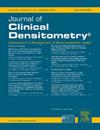Bioelectrical phase angle and impedance vectors are related to leg hip-femur density and bone geometry parameters in adolescent male soccer players
IF 1.6
4区 医学
Q4 ENDOCRINOLOGY & METABOLISM
引用次数: 0
Abstract
Background: Bone geometry parameters are essential for evaluating bone health and fracture risk in soccer players, whose physical demands affect their bone characteristics. However, studies on adolescent soccer players linking raw bioelectrical data to bone data are lacking, in addition to potential discrepancies in phase angle (PhA) values obtained using single-frequency (SF-BIA) and multifrequency (MF-BIA) bioelectrical impedance devices.
Aims: In this cross-sectional study, we aimed to compare raw bioelectrical impedance data (resistance (R), reactance (Xc), and PhA values) obtained using SF-BIA and MF-BIA devices and test the relationships among PhA and bioelectrical impedance vector analysis (BIVA) with bone mineral density (BMD), and leg hip-femur geometry (HF-G) parameters in adolescent male soccer players.
Methods: Raw bioelectrical impedance data were assessed using the SF-BIA and MF-BIA devices at a frequency of 50 kHz. The HF-G parameters were obtained by dual-energy X-ray absorptiometry. BIVA was used to compare bone data considering BMD and HF-G median values.
Results: Overall, 59 adolescent male soccer players participated in this study. Raw SF-BIA data had lower R values (-19.3 %, p < 0.001), but higher Xc (+5.3 %, p < 0.001) and PhA values (+20.3 %, p < 0.001) than when using MF-BIA data. PhA values obtained using SF-BIA (r = 0.27, p = 0.04) or MF-BIA (r = 0.43, p < 0.001) were positively correlated with total hip-femur BMD. Considering BIVA, the ellipses differed for the total BMD (p = 0.0018), neck BMD (p = 0.026), and cross-sectional area (p = 0.024).
Conclusion: The PhA and R values obtained using SF-BIA were higher than those obtained using MF-BIA, possibly because of the technological differences between the devices. However, the MF-BIA data suggests that PhA and BIVA can be used as tools for continuous use to warn of possible imbalances in bone tissue.
青少年男性足球运动员的腿部-髋-股骨密度和骨几何参数与生物电相位角和阻抗矢量有关
背景:足球运动员的身体需求影响其骨骼特征,因此骨几何参数对于评估其骨骼健康和骨折风险至关重要。然而,除了使用单频(SF-BIA)和多频(nf - bia)生物电阻抗装置获得的相位角(PhA)值可能存在差异外,还缺乏将原始生物电数据与骨骼数据联系起来的青少年足球运动员研究。目的:在这项横断面研究中,我们旨在比较使用SF-BIA和MF-BIA装置获得的原始生物电阻抗数据(电阻(R),电抗(Xc)和PhA值),并测试PhA和生物电阻抗矢量分析(BIVA)与青少年男性足球运动员骨密度(BMD)和腿-髋-股骨几何(HF-G)参数之间的关系。方法:使用SF-BIA和MF-BIA装置在50 kHz频率下评估原始生物电阻抗数据。采用双能x射线吸收法测定HF-G参数。BIVA用于比较考虑BMD和HF-G中位数的骨数据。结果:共有59名青少年男性足球运动员参与本研究。原始SF-BIA数据较低R值(-19.3 % p & lt; 0.001),但高Xc(+ 5.3 % p & lt; 0.001)和PhA值(+ 20.3 % p & lt; 0.001)比使用MF-BIA数据。使用SF-BIA (r = 0.27,p = 0.04)或MF-BIA (r = 0.43,p <; 0.001)获得的PhA值与髋-股骨总骨密度呈正相关。考虑到BIVA,椭圆在总骨密度(p = 0.0018)、颈部骨密度(p = 0.026)和横截面积(p = 0.024)上存在差异。结论:SF-BIA法测得的PhA和R值高于MF-BIA法测得的PhA和R值,可能与两种器械的工艺差异有关。然而,MF-BIA数据表明PhA和BIVA可以作为持续使用的工具来警告骨组织中可能存在的不平衡。
本文章由计算机程序翻译,如有差异,请以英文原文为准。
求助全文
约1分钟内获得全文
求助全文
来源期刊

Journal of Clinical Densitometry
医学-内分泌学与代谢
CiteScore
4.90
自引率
8.00%
发文量
92
审稿时长
90 days
期刊介绍:
The Journal is committed to serving ISCD''s mission - the education of heterogenous physician specialties and technologists who are involved in the clinical assessment of skeletal health. The focus of JCD is bone mass measurement, including epidemiology of bone mass, how drugs and diseases alter bone mass, new techniques and quality assurance in bone mass imaging technologies, and bone mass health/economics.
Combining high quality research and review articles with sound, practice-oriented advice, JCD meets the diverse diagnostic and management needs of radiologists, endocrinologists, nephrologists, rheumatologists, gynecologists, family physicians, internists, and technologists whose patients require diagnostic clinical densitometry for therapeutic management.
 求助内容:
求助内容: 应助结果提醒方式:
应助结果提醒方式:


